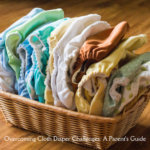Choosing to use prefold cloth diapers for your baby is a commendable decision that supports both environmental sustainability and your baby’s comfort. As a father of three with extensive experience in navigating the world of baby care, I’ve learned the ins and outs of using prefold cloth diapers effectively. This guide will help you understand the benefits, types, and proper use of prefold cloth diapers, ensuring you make the best choice for your little one.
Understanding Prefold Cloth Diapers
What Are Prefold Cloth Diapers? Prefold cloth diapers are a traditional form of cloth diapering, consisting of a rectangular piece of cloth divided into three sections, with the middle section being the most absorbent. They are made from natural fibers such as cotton, bamboo, or hemp, offering a soft and absorbent solution for baby’s diapering needs.
Benefits of Prefold Cloth Diapers
- Eco-Friendly: Prefold diapers significantly reduce waste compared to disposable diapers.
- Cost-Effective: They can be washed and reused many times, offering substantial savings over time.
- Gentle on Skin: Natural fibers are less likely to cause irritation or diaper rash on sensitive skin.
Choosing the Right Material and Size

Material Options
- Cotton: Highly absorbent and durable, ideal for everyday use.
- Bamboo: Softer and more absorbent than cotton, with natural antibacterial properties.
- Hemp: Extremely absorbent and strong, perfect for nighttime use.
Size and Fit
- Newborn to Toddler: Prefolds come in various sizes. Choose a size appropriate for your baby’s weight and growth stage.
- Adjustable Folds: Learn folding techniques that can adjust the diaper’s fit as your baby grows.
How to Use Prefold Cloth Diapers
Folding Techniques
- The Pad Fold: Simplest fold, essentially folding the diaper in thirds lengthwise. This is quick and easy, suitable for most waterproof diaper covers.
- The Angel Wing Fold: Offers more coverage and better containment of solids. The diaper is folded into a thin strip with extra fabric fanned out at the back, secured with a fastener.
Securing the Diaper
- Snappi Fastener: A popular and safer alternative to traditional safety pins.
- Diaper Covers: Required to waterproof the prefold, available in various materials like PUL (polyurethane laminate) or wool.
Caring for Your Prefold Cloth Diapers
Washing and Maintenance
- Pre-Wash: Pre-wash new diapers to remove natural oils and enhance absorbency.
- Regular Washing: Develop a routine to wash diapers every 2-3 days using a gentle, baby-safe detergent.
- Drying: Air dry or tumble dry on low to extend the life of the diapers.
Troubleshooting Common Issues
- Ammonia Smell: Rinse diapers thoroughly and use an occasional bleach soak to address buildup.
- Staining: Sunlight is a natural bleach that can help remove stains effectively.
Brand Recommendations and What to Avoid
Top Prefold Brands
- Brand A: Known for their high-quality cotton prefolds that are both durable and highly absorbent.
- Brand B: Offers a variety of bamboo prefolds that are incredibly soft and eco-friendly.
- Brand C: Provides hemp prefold options that excel in overnight absorbency.
What to Avoid
- Synthetic Fibers: Can reduce the breathability and absorbency of diapers.
- Poorly Sized Covers: Ensure the diaper cover fits well over the prefold to prevent leaks.
Personal Experience and Tips
Practical Advice from a Dad of Three
- Stay Organized: Keep a designated area for clean and dirty diapers to streamline your diapering process.
- Involve Your Kids: Let older siblings help with preparing or folding diapers to make it a family activity.
- On-the-Go Solutions: Always pack a wet bag and extra prefold diapers when traveling to manage changes easily.
Making the Sustainable Choice
Choosing the best prefold cloth diapers for your baby involves understanding the different materials, sizes, and techniques that can enhance your diapering experience. With the right approach, prefold diapers not only offer an eco-friendly and cost-effective option but also ensure your baby stays comfortable and rash-free.
As you embark on this journey, remember that each baby is unique, and what works for one may not work for another. The key is to remain flexible and open to adjusting your strategies as needed. Embrace the benefits of cloth diapering not just for your baby, but for the environment as well.
For more detailed insights on prefold cloth diapers, visit our comprehensive guide at ParentingChic.com.







